普通语言学笔记整理 辉修哥版
- 格式:doc
- 大小:61.00 KB
- 文档页数:6
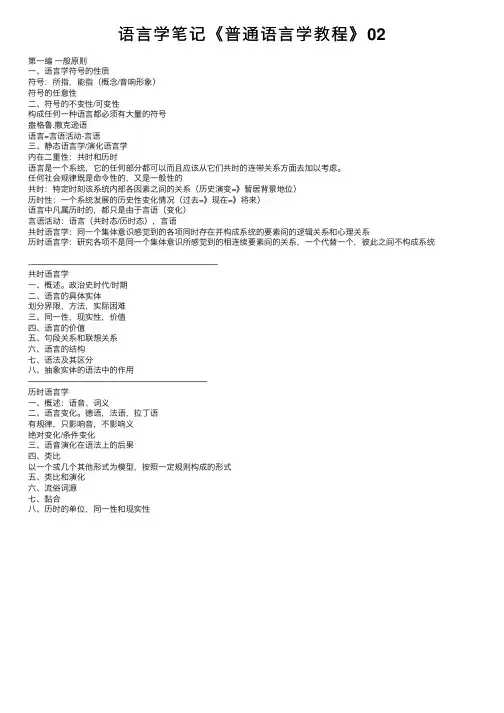
语⾔学笔记《普通语⾔学教程》02第⼀编⼀般原则⼀、语⾔学符号的性质符号:所指,能指(概念/⾳响形象)符号的任意性⼆、符号的不变性/可变性构成任何⼀种语⾔都必须有⼤量的符号盎格鲁.撒克逊语语⾔=⾔语活动-⾔语三、静态语⾔学/演化语⾔学内在⼆重性:共时和历时语⾔是⼀个系统,它的任何部分都可以⽽且应该从它们共时的连带关系⽅⾯去加以考虑。
任何社会规律既是命令性的,⼜是⼀般性的共时:特定时刻该系统内部各因素之间的关系(历史演变=》暂居背景地位)历时性:⼀个系统发展的历史性变化情况(过去=》现在=》将来)语⾔中凡属历时的,都只是由于⾔语(变化)⾔语活动:语⾔(共时态/历时态),⾔语共时语⾔学:同⼀个集体意识感觉到的各项同时存在并构成系统的要素间的逻辑关系和⼼理关系历时语⾔学:研究各项不是同⼀个集体意识所感觉到的相连续要素间的关系,⼀个代替⼀个,彼此之间不构成系统-———————————————————————共时语⾔学⼀、概述。
政治史时代/时期⼆、语⾔的具体实体划分界限,⽅法,实际困难三、同⼀性,现实性,价值四、语⾔的价值五、句段关系和联想关系六、语⾔的结构七、语法及其区分⼋、抽象实体的语法中的作⽤——————————————————————历时语⾔学⼀、概述:语⾳、词义⼆、语⾔变化。
德语,法语,拉丁语有规律,只影响⾳,不影响义绝对变化/条件变化三、语⾳演化在语法上的后果四、类⽐以⼀个或⼏个其他形式为模型,按照⼀定规则构成的形式五、类⽐和演化六、流俗词源七、黏合⼋、历时的单位,同⼀性和现实性。

本来想做一个比较完整的读书笔记的,因为这本书的地位很重要。
结果发现所需的精力似乎比我想象的要多很多,于是只好随便说两句了。
这里没有太多原创的想法,写的目的主要在于:不是按照作者写书的顺序,而是按照我理解作者的逻辑,来把部分要点做出总结。
着重在语言的效果上,因此对很多语言学概念并没有做出讨论。
在最后部分提出了一些挑战,不过没有具体的解决方法。
我认为索绪尔所建立的语言学研究方法最重要的作用是它使我们注意到语言是一项社会制度这一点(至少对我来说是这样的)。
他理解、定义语言的新方式以及与之相应的研究语言的新方法,无不向我们指出了语言符合“社会制度”这一概念的证据以及语言自身的性质所造成的这项制度的特点及特殊后果。
索绪尔对语言和言语的二分能够证明这一点。
经过这样的二分,语言是属于集体的产物便得到了强调,因为这说明它不是说话者个人的行为,后者应当是“言语”。
而语言,是所有言语行为必须遵守的规则。
不论说话者想要表达的思想可以是多么不同(在这一点上他们可以是自由的),他们赖以运用的规则始终是相同的(在这一点上他们是完全不自由的)。
如果说这一对概念道出了语言是社会制度这一本质,那么另一对概念——共时态与历时态——则道出了索绪尔把语言作为社会制度来研究(也就是从本质上来研究语言)的愿望。
因为,根据索绪尔的观点,从语言的共时态里我们看到的是这个完整的系统结构,而从历时态中我们看到的是个别要素的偶然变化;那么显然,要研究这一制度是如何运作的必须看到前者的面貌,而索绪尔对语言学最大的那些贡献恰恰是在前者上的。
开始这样的研究之后,我们便发现了个人在这个制度面前的消极。
而语言在实现这一点上是有其特殊方式的。
在索绪尔看来,概念不是先于词而存在的,而是语言这个中介,在一片连续的声音中划出了一段来辅助我们辨认从模糊的思想中划出的一块,我们才可能认清概念。
这就是语言作为一个符号系统作用于我们的方式:它依靠能指的各项间在物理上的差别(音段的区别),来产生各项所指对我们显现出的不同于其他所指的意义,以此达成我们理解世界的方式。
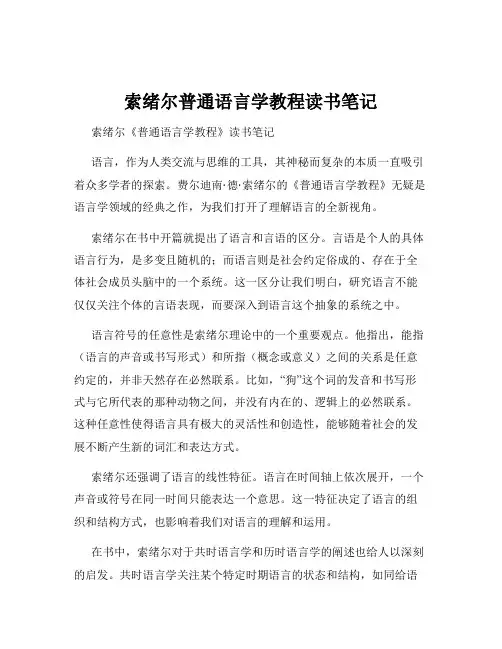
索绪尔普通语言学教程读书笔记索绪尔《普通语言学教程》读书笔记语言,作为人类交流与思维的工具,其神秘而复杂的本质一直吸引着众多学者的探索。
费尔迪南·德·索绪尔的《普通语言学教程》无疑是语言学领域的经典之作,为我们打开了理解语言的全新视角。
索绪尔在书中开篇就提出了语言和言语的区分。
言语是个人的具体语言行为,是多变且随机的;而语言则是社会约定俗成的、存在于全体社会成员头脑中的一个系统。
这一区分让我们明白,研究语言不能仅仅关注个体的言语表现,而要深入到语言这个抽象的系统之中。
语言符号的任意性是索绪尔理论中的一个重要观点。
他指出,能指(语言的声音或书写形式)和所指(概念或意义)之间的关系是任意约定的,并非天然存在必然联系。
比如,“狗”这个词的发音和书写形式与它所代表的那种动物之间,并没有内在的、逻辑上的必然联系。
这种任意性使得语言具有极大的灵活性和创造性,能够随着社会的发展不断产生新的词汇和表达方式。
索绪尔还强调了语言的线性特征。
语言在时间轴上依次展开,一个声音或符号在同一时间只能表达一个意思。
这一特征决定了语言的组织和结构方式,也影响着我们对语言的理解和运用。
在书中,索绪尔对于共时语言学和历时语言学的阐述也给人以深刻的启发。
共时语言学关注某个特定时期语言的状态和结构,如同给语言拍一张“快照”;而历时语言学则研究语言的演变历史,追踪其发展的轨迹。
索绪尔认为,共时研究比历时研究更为重要,因为只有了解了语言在特定时期的结构和规则,才能更好地理解语言的本质。
此外,索绪尔提出了组合关系和聚合关系这对重要概念。
组合关系指语言符号在话语中按照线性顺序依次排列所形成的关系;聚合关系则是在同一结构位置上能够相互替换的具有相同功能的语言单位之间的关系。
通过这对概念,我们可以更清晰地看到语言的内部结构和组织规律。
索绪尔的理论不仅对语言学的发展产生了深远影响,也为其他相关学科提供了重要的理论基础和研究方法。
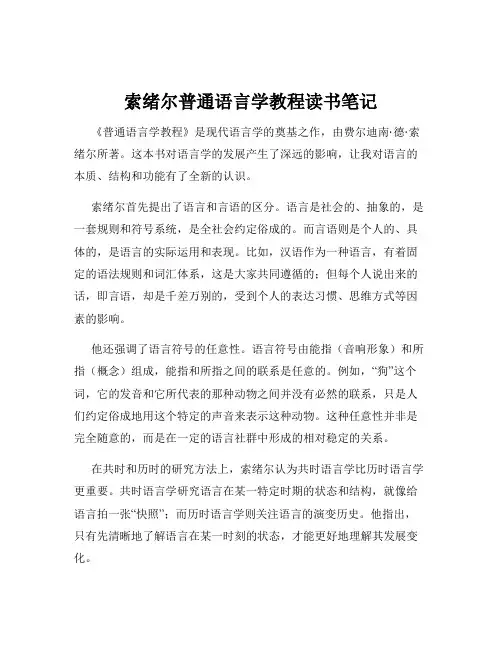
索绪尔普通语言学教程读书笔记《普通语言学教程》是现代语言学的奠基之作,由费尔迪南·德·索绪尔所著。
这本书对语言学的发展产生了深远的影响,让我对语言的本质、结构和功能有了全新的认识。
索绪尔首先提出了语言和言语的区分。
语言是社会的、抽象的,是一套规则和符号系统,是全社会约定俗成的。
而言语则是个人的、具体的,是语言的实际运用和表现。
比如,汉语作为一种语言,有着固定的语法规则和词汇体系,这是大家共同遵循的;但每个人说出来的话,即言语,却是千差万别的,受到个人的表达习惯、思维方式等因素的影响。
他还强调了语言符号的任意性。
语言符号由能指(音响形象)和所指(概念)组成,能指和所指之间的联系是任意的。
例如,“狗”这个词,它的发音和它所代表的那种动物之间并没有必然的联系,只是人们约定俗成地用这个特定的声音来表示这种动物。
这种任意性并非是完全随意的,而是在一定的语言社群中形成的相对稳定的关系。
在共时和历时的研究方法上,索绪尔认为共时语言学比历时语言学更重要。
共时语言学研究语言在某一特定时期的状态和结构,就像给语言拍一张“快照”;而历时语言学则关注语言的演变历史。
他指出,只有先清晰地了解语言在某一时刻的状态,才能更好地理解其发展变化。
索绪尔关于组合关系和聚合关系的论述也让我深受启发。
组合关系是语言符号在话语中的线性排列关系,比如“我吃饭”,“我”“吃”“饭”按照一定的顺序组合在一起。
聚合关系则是在某一结构位置上能够互相替换的具有相同功能的单位之间的关系,比如在“我吃饭”这个结构中,“我”可以被“他”“她”等替代,“吃”可以被“喝”“尝”等替代。
书中还提到了语言的系统性。
语言不是孤立的符号的简单堆积,而是一个相互关联、相互制约的系统。
系统中的每个要素都根据其与其他要素的关系而确定自身的价值。
一个符号的意义往往取决于它在系统中与其他符号的对立和差异。
比如“红”这个颜色词,它的意义是通过与“绿”“蓝”“黄”等其他颜色词的对比而确定的。
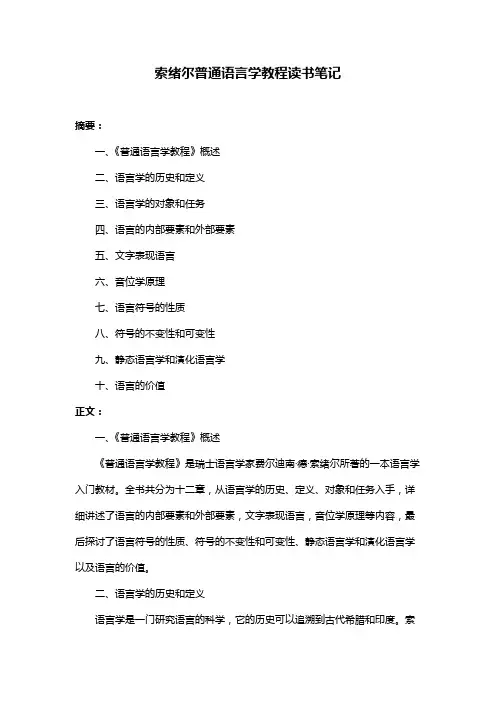
索绪尔普通语言学教程读书笔记摘要:一、《普通语言学教程》概述二、语言学的历史和定义三、语言学的对象和任务四、语言的内部要素和外部要素五、文字表现语言六、音位学原理七、语言符号的性质八、符号的不变性和可变性九、静态语言学和演化语言学十、语言的价值正文:一、《普通语言学教程》概述《普通语言学教程》是瑞士语言学家费尔迪南·德·索绪尔所著的一本语言学入门教材。
全书共分为十二章,从语言学的历史、定义、对象和任务入手,详细讲述了语言的内部要素和外部要素,文字表现语言,音位学原理等内容,最后探讨了语言符号的性质、符号的不变性和可变性、静态语言学和演化语言学以及语言的价值。
二、语言学的历史和定义语言学是一门研究语言的科学,它的历史可以追溯到古代希腊和印度。
索绪尔认为,语言学应该被定义为对语言事实的系统性研究。
三、语言学的对象和任务语言学的对象是语言,包括语言的结构、功能和演变。
语言学的任务是揭示语言的内在规律,解释语言现象,探究语言的起源和发展。
四、语言的内部要素和外部要素语言的内部要素包括音位、词汇、语法等,外部要素包括语言环境和语言使用者。
五、文字表现语言文字是语言的视觉表现形式,它通过书写系统记录和传播语言信息。
六、音位学原理音位学是语言学的一个分支,它研究语音的基本单位——音位。
音位学原理包括音位的定义、分类和组合规律等。
七、语言符号的性质语言符号是语言的基本单位,它由声音和意义两部分组成。
语言符号的性质包括任意性、线性性和差异性等。
八、符号的不变性和可变性符号的不变性指的是符号的形式和意义在特定语境下的固定性,符号的可变性指的是符号的形式和意义在不同语境下的变化性。
九、静态语言学和演化语言学静态语言学研究的是语言的静态结构,演化语言学研究的是语言的演变过程。
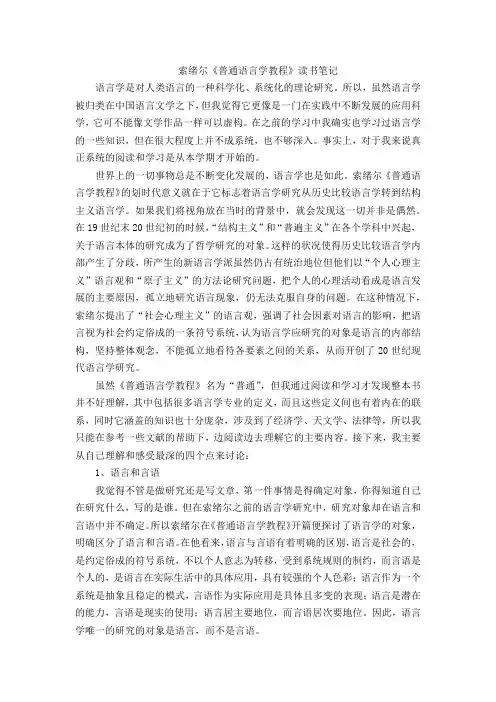
索绪尔《普通语言学教程》读书笔记语言学是对人类语言的一种科学化、系统化的理论研究。
所以,虽然语言学被归类在中国语言文学之下,但我觉得它更像是一门在实践中不断发展的应用科学,它可不能像文学作品一样可以虚构。
在之前的学习中我确实也学习过语言学的一些知识,但在很大程度上并不成系统,也不够深入。
事实上,对于我来说真正系统的阅读和学习是从本学期才开始的。
世界上的一切事物总是不断变化发展的,语言学也是如此。
索绪尔《普通语言学教程》的划时代意义就在于它标志着语言学研究从历史比较语言学转到结构主义语言学。
如果我们将视角放在当时的背景中,就会发现这一切并非是偶然。
在19世纪末20世纪初的时候,“结构主义”和“普遍主义”在各个学科中兴起,关于语言本体的研究成为了哲学研究的对象。
这样的状况使得历史比较语言学内部产生了分歧,所产生的新语言学派虽然仍占有统治地位但他们以“个人心理主义”语言观和“原子主义”的方法论研究问题,把个人的心理活动看成是语言发展的主要原因,孤立地研究语言现象,仍无法克服自身的问题。
在这种情况下,索绪尔提出了“社会心理主义”的语言观,强调了社会因素对语言的影响,把语言视为社会约定俗成的一条符号系统,认为语言学应研究的对象是语言的内部结构,坚持整体观念,不能孤立地看待各要素之间的关系,从而开创了20世纪现代语言学研究。
虽然《普通语言学教程》名为“普通”,但我通过阅读和学习才发现整本书并不好理解,其中包括很多语言学专业的定义,而且这些定义间也有着内在的联系,同时它涵盖的知识也十分庞杂,涉及到了经济学、天文学、法律等,所以我只能在参考一些文献的帮助下,边阅读边去理解它的主要内容。
接下来,我主要从自己理解和感受最深的四个点来讨论:1、语言和言语我觉得不管是做研究还是写文章,第一件事情是得确定对象,你得知道自己在研究什么,写的是谁。
但在索绪尔之前的语言学研究中,研究对象却在语言和言语中并不确定。
所以索绪尔在《普通语言学教程》开篇便探讨了语言学的对象,明确区分了语言和言语。
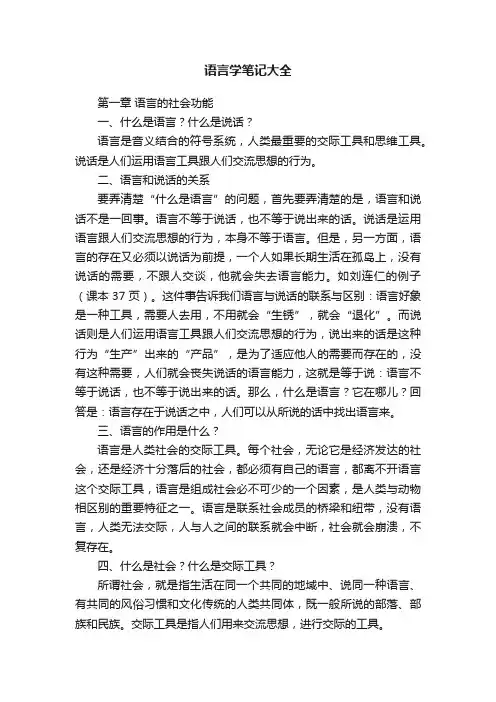
语言学笔记大全第一章语言的社会功能一、什么是语言?什么是说话?语言是音义结合的符号系统,人类最重要的交际工具和思维工具。
说话是人们运用语言工具跟人们交流思想的行为。
二、语言和说话的关系要弄清楚“什么是语言”的问题,首先要弄清楚的是,语言和说话不是一回事。
语言不等于说话,也不等于说出来的话。
说话是运用语言跟人们交流思想的行为,本身不等于语言。
但是,另一方面,语言的存在又必须以说话为前提,一个人如果长期生活在孤岛上,没有说话的需要,不跟人交谈,他就会失去语言能力。
如刘连仁的例子(课本37页)。
这件事告诉我们语言与说话的联系与区别:语言好象是一种工具,需要人去用,不用就会“生锈”,就会“退化”。
而说话则是人们运用语言工具跟人们交流思想的行为,说出来的话是这种行为“生产”出来的“产品”,是为了适应他人的需要而存在的,没有这种需要,人们就会丧失说话的语言能力,这就是等于说:语言不等于说话,也不等于说出来的话。
那么,什么是语言?它在哪儿?回答是:语言存在于说话之中,人们可以从所说的话中找出语言来。
三、语言的作用是什么?语言是人类社会的交际工具。
每个社会,无论它是经济发达的社会,还是经济十分落后的社会,都必须有自己的语言,都离不开语言这个交际工具,语言是组成社会必不可少的一个因素,是人类与动物相区别的重要特征之一。
语言是联系社会成员的桥梁和纽带,没有语言,人类无法交际,人与人之间的联系就会中断,社会就会崩溃,不复存在。
四、什么是社会?什么是交际工具?所谓社会,就是指生活在同一个共同的地域中、说同一种语言、有共同的风俗习惯和文化传统的人类共同体,既一般所说的部落、部族和民族。
交际工具是指人们用来交流思想,进行交际的工具。
五、为什么说语言是人类最重要的交际工具?人们在进行社会交际的时候,除了运用语言传递信息外,也可以借助其他手段传递信息,表达思想。
比如运动场上,篮球教练用手势表示谁犯规、谁发球等内容,不用语言;部队用长短不同的号声表示起床、集合、冲锋、撤退等信息;在海上,船与船之间用旗语传递信息等等。
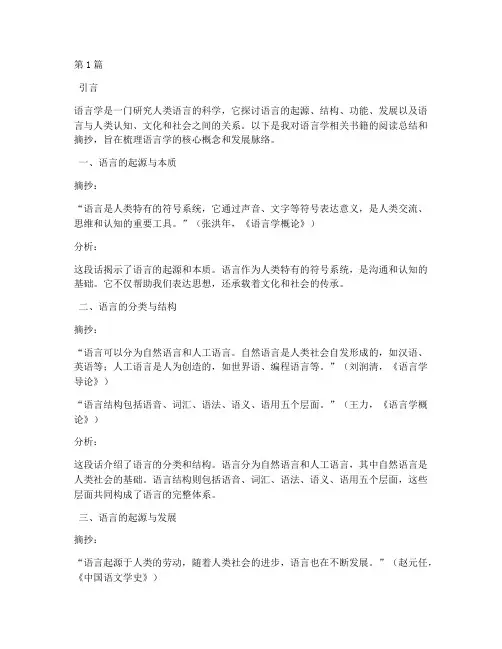
第1篇引言语言学是一门研究人类语言的科学,它探讨语言的起源、结构、功能、发展以及语言与人类认知、文化和社会之间的关系。
以下是我对语言学相关书籍的阅读总结和摘抄,旨在梳理语言学的核心概念和发展脉络。
一、语言的起源与本质摘抄:“语言是人类特有的符号系统,它通过声音、文字等符号表达意义,是人类交流、思维和认知的重要工具。
”(张洪年,《语言学概论》)分析:这段话揭示了语言的起源和本质。
语言作为人类特有的符号系统,是沟通和认知的基础。
它不仅帮助我们表达思想,还承载着文化和社会的传承。
二、语言的分类与结构摘抄:“语言可以分为自然语言和人工语言。
自然语言是人类社会自发形成的,如汉语、英语等;人工语言是人为创造的,如世界语、编程语言等。
”(刘润清,《语言学导论》)“语言结构包括语音、词汇、语法、语义、语用五个层面。
”(王力,《语言学概论》)分析:这段话介绍了语言的分类和结构。
语言分为自然语言和人工语言,其中自然语言是人类社会的基础。
语言结构则包括语音、词汇、语法、语义、语用五个层面,这些层面共同构成了语言的完整体系。
三、语言的起源与发展摘抄:“语言起源于人类的劳动,随着人类社会的进步,语言也在不断发展。
”(赵元任,《中国语文学史》)“语言的发展受到社会、经济、文化等多方面因素的影响。
”(高名凯,《语言学史》)分析:这段话探讨了语言的起源和发展。
语言的起源与人类的劳动密切相关,随着社会的发展,语言也在不断演变。
语言的发展受到社会、经济、文化等多方面因素的影响,这些因素共同推动着语言的发展。
四、语言的认知基础摘抄:“语言是人类认知的工具,它反映了人类的思维方式和认知结构。
”(吴福祥,《认知语言学导论》)“语言的认知基础包括语言符号的认知、语义的认知、语用的认知等。
”(胡亚敏,《认知语言学》)分析:这段话阐述了语言的认知基础。
语言不仅是沟通的工具,也是人类认知的基础。
语言的认知基础包括语言符号的认知、语义的认知、语用的认知等,这些认知基础共同构成了语言的认知体系。
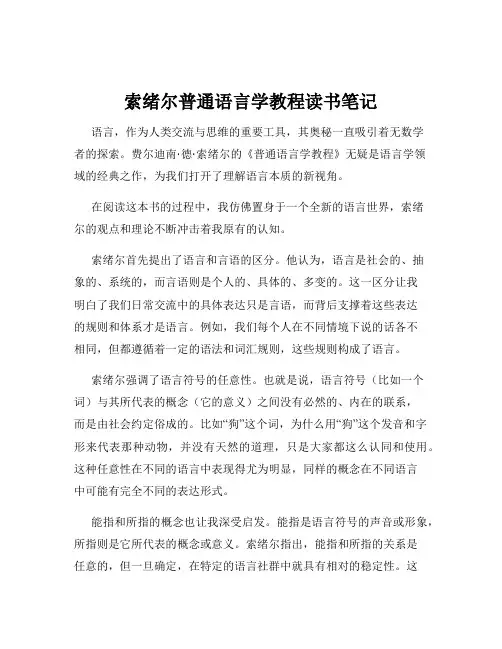
索绪尔普通语言学教程读书笔记语言,作为人类交流与思维的重要工具,其奥秘一直吸引着无数学者的探索。
费尔迪南·德·索绪尔的《普通语言学教程》无疑是语言学领域的经典之作,为我们打开了理解语言本质的新视角。
在阅读这本书的过程中,我仿佛置身于一个全新的语言世界,索绪尔的观点和理论不断冲击着我原有的认知。
索绪尔首先提出了语言和言语的区分。
他认为,语言是社会的、抽象的、系统的,而言语则是个人的、具体的、多变的。
这一区分让我明白了我们日常交流中的具体表达只是言语,而背后支撑着这些表达的规则和体系才是语言。
例如,我们每个人在不同情境下说的话各不相同,但都遵循着一定的语法和词汇规则,这些规则构成了语言。
索绪尔强调了语言符号的任意性。
也就是说,语言符号(比如一个词)与其所代表的概念(它的意义)之间没有必然的、内在的联系,而是由社会约定俗成的。
比如“狗”这个词,为什么用“狗”这个发音和字形来代表那种动物,并没有天然的道理,只是大家都这么认同和使用。
这种任意性在不同的语言中表现得尤为明显,同样的概念在不同语言中可能有完全不同的表达形式。
能指和所指的概念也让我深受启发。
能指是语言符号的声音或形象,所指则是它所代表的概念或意义。
索绪尔指出,能指和所指的关系是任意的,但一旦确定,在特定的语言社群中就具有相对的稳定性。
这就解释了为什么语言能够传达意义并且被人们理解,同时也说明了语言会随着时间和社会的变化而发生演变。
索绪尔还探讨了语言的系统性。
他认为语言是一个由相互关联的要素组成的系统,其中各个要素的价值取决于它们在系统中的位置和与其他要素的关系。
就像在象棋中,每个棋子的价值不是孤立存在的,而是取决于它在整个棋局中的位置和作用,语言中的词汇、语法规则等也是如此。
此外,索绪尔对于共时语言学和历时语言学的划分也非常有意义。
共时语言学研究特定时期语言的状态和结构,不考虑其历史演变;历时语言学则关注语言的发展变化。
这种划分让我们能够更清晰地从不同角度去研究语言,既可以了解语言在某个时刻的静态结构,又可以追溯其历史发展的轨迹。
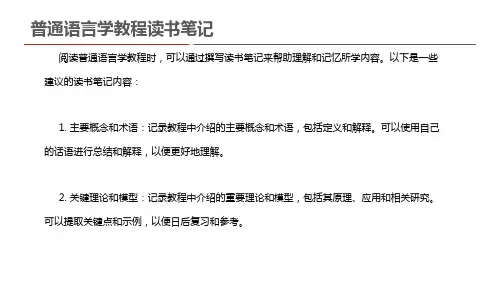
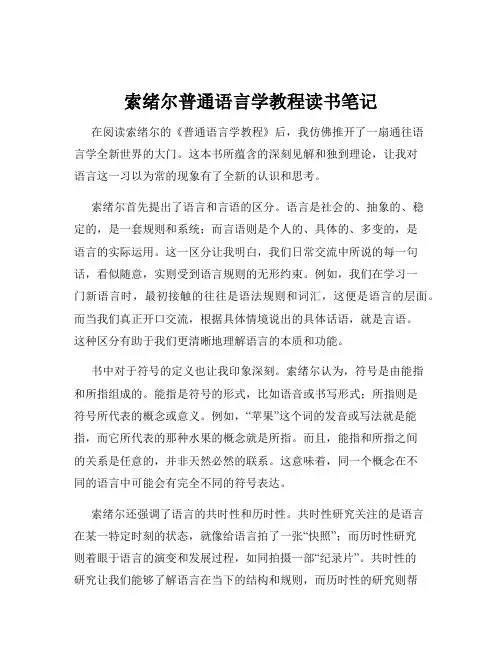
索绪尔普通语言学教程读书笔记在阅读索绪尔的《普通语言学教程》后,我仿佛推开了一扇通往语言学全新世界的大门。
这本书所蕴含的深刻见解和独到理论,让我对语言这一习以为常的现象有了全新的认识和思考。
索绪尔首先提出了语言和言语的区分。
语言是社会的、抽象的、稳定的,是一套规则和系统;而言语则是个人的、具体的、多变的,是语言的实际运用。
这一区分让我明白,我们日常交流中所说的每一句话,看似随意,实则受到语言规则的无形约束。
例如,我们在学习一门新语言时,最初接触的往往是语法规则和词汇,这便是语言的层面。
而当我们真正开口交流,根据具体情境说出的具体话语,就是言语。
这种区分有助于我们更清晰地理解语言的本质和功能。
书中对于符号的定义也让我印象深刻。
索绪尔认为,符号是由能指和所指组成的。
能指是符号的形式,比如语音或书写形式;所指则是符号所代表的概念或意义。
例如,“苹果”这个词的发音或写法就是能指,而它所代表的那种水果的概念就是所指。
而且,能指和所指之间的关系是任意的,并非天然必然的联系。
这意味着,同一个概念在不同的语言中可能会有完全不同的符号表达。
索绪尔还强调了语言的共时性和历时性。
共时性研究关注的是语言在某一特定时刻的状态,就像给语言拍了一张“快照”;而历时性研究则着眼于语言的演变和发展过程,如同拍摄一部“纪录片”。
共时性的研究让我们能够了解语言在当下的结构和规则,而历时性的研究则帮助我们追溯语言的变迁轨迹。
这让我想到,我们在学习古代汉语和现代汉语时,明显能感受到词汇、语法等方面的差异,这正是语言历时性变化的体现。
在谈到语言的系统性时,索绪尔指出语言是一个相互关联的系统,其中各个要素相互依存、相互制约。
一个要素的变化可能会引起整个系统的调整。
比如,某个新词汇的出现,可能会影响到与之相关的词汇的使用频率和语义范围。
此外,索绪尔对于语言的线性特征也有精彩的论述。
他认为语言的表达是在时间轴上依次展开的,具有先后顺序。
这就使得语言在表达复杂的思想时,需要遵循一定的逻辑和语法规则,以确保信息的准确传递。
《普通语言学教程》xx绪论第一章语言学xx一瞥语法(规范)-语文学(过于注重书面语)-比较语文学或比较语法(只比较)-新语法学派(语言集团集体精神的产物)第二章语言学的材料和任务;与毗邻科学的关系语言学的任务是:a 对一切能够得到的语言进行描写并整理他们的历史,尽可能重建每个语系的母语;b 寻求在一切语言中永恒地普遍地起作用的力量,整理出能概况一切历史特殊现象的一般规律;c 确定自己的界限和定义。
它与社会心理学、生理学、语文学相关。
语言学也有实际用途,特别是对于那些利用文献的人,另外对一般修养也很重要。
第三章语言学的对象定义——在任何时候,语言都是现行制度和过去的产物。
我们的研究方法是一开始就站在语言的阵地上,把它当做xx活动的其他一切表现的准则。
语言和xx活动不能混为一谈,它只是xx活动的一个确定的部分,而且当然是一个主要部分,它既是xx机能的社会产物,又是社会集团为了使个人有可能行使这机能所采用的一整套必不可少的规约。
语言本身是一个整体,一个分类的原则。
它是一种约定俗成的xx,人们同意使用什么符号,这符号的性质是无关轻重的。
对人类天赋的不是口头的xx活动,而是构成语言——即一套和不同的观念相当的不同的符号——的机能。
人们说话的机能——不管是天赋的或非天赋的——只有借助于集体所创造和提供的工具才能运用,所以,说语言使xx活动成为统一体,绝不是空想。
语言在xx活动事实中的地位——xx循环重建:心理现象-生理过程-物理过程-生理过程-心理现象(c-i)这一主动过程称为执行部分,(i-c)这一被动过程称为接受部分,此外还有联合和配置的机能。
语言是社会的、主要的,xx 是个人的、偶然的、从属的。
语言的特征是:1 他是xx活动事实的混杂的总体中的一个十分确定的对象,是xx的社会部分。
2 语言是人们能够分出来加以研究的对象。
3 xx是异质的,而规定下来的语言是同质的,它是一种符号系统,在系统中,只有意义和音响形象的结合是主要的,符号的两个部分都是心理的。
索绪尔(Ferdinand de Saussure)是二十世纪最重要的语言学家之一,他的理论为现代语言学的发展做出了重大贡献。
他的著作《通识言语学教程》(Course in General Linguistics)是他关于语言学的重要著作之一,也是他的学生Charles Bally和Albert Sechehaye在他去世后整理出版的。
这本书对于理解语言现象和语言结构有着深远的影响,尤其是对后来结构主义和后结构主义等流派的形成产生了巨大影响。
本文将对索绪尔普通语言学教程进行一系列读书笔记,以期更深入地理解和思考他的语言学理论。
一、索绪尔对语言学的贡献1.1 语言是一种系统索绪尔认为语言是一种符号系统,是一种由语音、文字、语法等组成的系统。
他提出了“语言是一种系统”的观点,强调了语言的内部联系和结构。
他指出,语言中的各种元素(如音素、词汇、句法等)之间存在着密切的联系和相互配合,构成了一个完整的系统。
1.2 语言是演化的产物索绪尔认为语言是一种演化的产物,是人类社会历史发展的产物。
他强调了语言与社会、文化的密切关系,指出语言是在社会实践中不断演化和发展的。
他还提出了语言的“同质性”和“异质性”观念,指出语言既具有一定的相似性,又具有一定的差异性。
1.3 语言是符号系统索绪尔强调了语言的符号性质,认为语言是一种符号系统,是一种用来表达意义和传递信息的符号系统。
他指出,语言中的各种语音、文字、句法等元素都具有符号性质,是人们用来交流思想、感情和信息的工具。
二、索绪尔普通语言学教程的主要内容及思想2.1 语言的结构和功能索绪尔在《通识言语学教程》中系统地阐述了语言的结构和功能。
他提出了语言的“内部结构”和“外部功能”的概念,强调了语言内部各种元素之间的关系和作用,以及语言在社会、文化等外部领域的功能和影响。
2.2 语言的演化和变化索绪尔对语言的演化和变化进行了深入的讨论,指出语言是在社会历史演变中不断发展和变化的产物。
普通语言学教程知识点总结第一部分:语言学概论1. 语言的定义语言是一种符号系统,通过语音或文字来传递意义,是人类思维和交流的重要工具。
2. 语言学的研究对象语言学研究语言的结构、形式、功能、发展以及语言在社会和文化中的作用。
3. 语言的基本特征语言的基本特征包括:任意性、符号性、交际性、复杂性、可变性、文化载体等。
4. 语言的层次结构语言的层次结构包括语音层、词汇层、词组层、句子层和语篇层。
第二部分:语言习得1. 语言的习得过程语言习得是指个体在学习自己的母语时所经历的过程,包括语音、词汇、语法和语用等方面的发展。
2. 语言习得的阶段语言习得包括婴儿期、幼儿期、儿童期、青少年期和成人期等不同阶段,每个阶段都有其特定的语言发展特点。
3. 习得语言与学习语言的区别习得语言是指自然而然地掌握母语的过程,而学习语言则是指通过学习来掌握一门语言。
第三部分:语音学1. 语音学的对象和内容语音学研究语音的发音、形成规律和分类,以及语音在语言中的功能。
2. 语音的分类语音可以分为辅音和元音,辅音可以再分为浊音和清音,元音可以分为前元音、中元音和后元音。
3. 语音的发音器官人类语音的发音器官包括声门、喉头、口腔、舌头、鼻腔等部位。
4. 语音的基本特征语音的基本特征包括调音的高低、音量的大小、音调的升降和语调的变化等。
第四部分:语音学1. 语法学的研究对象和内容语法学研究语言的结构和形式,包括词类、句子成分、句法关系等内容。
2. 词法和句法词法研究词汇的组成和形态变化规律,句法研究句子的结构和成分之间的关系。
3. 语法现象的分类语法现象可以分为形态学现象、句法现象和语义现象等。
4. 语法规则和规则性语法规则是语言使用中的规范,语法规则性是指语法现象的稳定性和规律性。
第五部分:语义学1. 语义学的研究对象和内容语义学研究语言中的词汇和句子的意义和语用规则。
2. 语义的分类语义可以分为词义和句义两个方面,词义是指词汇的意义,句义是指句子的意义。
第1篇一、引言语言学作为一门研究人类语言的科学,历史悠久,内容丰富。
语言学理论基础是语言学研究的基石,涉及语言的本质、起源、结构、功能等多个方面。
以下是对语言学理论基础的笔记摘抄,旨在梳理和总结语言学理论的核心观点。
二、语言的本质1. 符号论:语言是一种符号系统,由符号、符号系统和符号行为构成。
符号是语言的基本单位,具有指代和表达功能。
- 符号:指代某种意义的符号,如词汇、语法符号等。
- 符号系统:由一系列符号构成的体系,如语言系统。
- 符号行为:符号的运用和表达行为。
2. 功能论:语言是人类社会交往的工具,具有表达、沟通、协调等功能。
- 表达功能:通过语言表达思想、情感、意愿等。
- 沟通功能:在人与人之间传递信息、建立联系。
- 协调功能:在社会生活中调节人际关系,维护社会秩序。
3. 结构论:语言是一种结构化的符号系统,具有层次性和规则性。
- 层次性:语言系统分为语音、词汇、语法等层次。
- 规则性:语言系统遵循一定的语法规则。
三、语言的起源1. 生物进化论:认为语言的起源与人类大脑的进化有关,是人类适应环境、提高生存能力的结果。
2. 模仿论:认为语言的起源是人类模仿自然界声音和动物叫声的结果。
3. 劳动起源论:认为语言的起源与人类的劳动活动有关,是人类为了协作、分工而产生的。
4. 社会交往论:认为语言的起源是人类社会交往的需要,是人类为了沟通、表达思想而产生的。
四、语言的结构1. 语音结构:语音是语言的物质基础,包括音素、音节、音节结构等。
- 音素:构成语音的最小单位,如“b”、“p”等。
- 音节:由音素构成的语音组合,如“ba”、“pa”等。
- 音节结构:音节内部的结构关系,如音节的重音、声调等。
2. 词汇结构:词汇是语言的建筑材料,包括词、短语、句子等。
- 词:构成词汇的基本单位,如“人”、“树”等。
- 短语:由词或词组构成的组合,如“美丽的花园”。
- 句子:表达完整意义的语言单位,如“我爱祖国”。
普通语言学笔记整理辉修哥版Chapter 11.2 What is Language定义填空【1】To give the barest of definition,language is a means of verbal communication.(a)human speech;(b)the ability to communicate by this means;(c)a system of vocal sounds and combinations of such sounds to which meaning is attributed,used for the expression or communication of thoughts and feelings(d)the written representation of such a system【2】(a)any means of expressing or communicating,as gesture,signs,or animal sounds;(b)a special set of symbols,letters,numerals,rules etc.1.3 Design Features of Language 简答(1)Arbitrariness: the form of linguistic signs bear no natural relationship to their meaning. (2)Duality: is meant the property of having two levels of structures. such that units of the primary level are composed of elements of secondary level and each of the two levels has its own principles of organization.(3)Creativity : ①we mean language is resourceful because of its duality and its recursiveness.②One of the reasons why language is actually a far more complicated entity than traffic lights is that we can use it to create new meaning. For example,between birds,which can only convey a limited range of message.③Language is creative in another sense,that is ,its potential to create endless sentences.The recursive nature of language provides a theoretical basis for this possibility.(4)Displacement benefits human beings by giving them the power to handle generalizations and abstractions.1.5 Function of Language(1)Informative: ideational function in the framework of functional grammar(2)Interpersonal Function版本一Attached to the interpersonal function of language is its function of the expression of nguage marks our identity, physically in terms of age, sex, and voiceprints; psychologically in terms of language and personality, intelligence; geographically in terms of accents, dialects; ethnically in terms of social stratification, class, status, role, solidarity and distance. 版本二language serves to establish and maintain social rules, which include the communication roles created by language itself. Through this function, social groups are delimited, and the individual is identified and reinforced, since by enabling him to interact with others language also serves in the expression and development of his own personality(3)Performative(4)Emotive function(5)Phatic Communion it refers to the social interaction of language. Broadly speaking, this function refers to expressions that help define and maintain interpersonal relations, such as slangs, jokes. We have to learn a large repertoire of such usages if we are to interact comfortably with different people(6)Recreational Function(7)Metalingual Function : our language can be used to talk about itself.For example,I can use the word book to talk about a book.1.6Linguistics: is usually defined as the science of language or,alternatively,as the scientific study of language.1.7 Main Branches of Linguistics1.7.1 Phonetics: studies speech sounds,including the production of speech.that is how speech sounds are actually made,transmitted and received,the description and classification of speech sounds,words and connected speech.1.7.2 Phonology:studies the rules governing the structure,distribution,and sequencing of speech sounds and the shape of syllables.It deals with sound system of a language bu treating phoneme as the point of departure.1.7.3 Morphology:is concerned with the internal organization of words.It studies the minimal units of meaning-morphemes and word-formation processes.1.7.4 Syntax:is about principles of forming and understanding correct English sentences.it also refers to the study of the rules governing the way words are combined to form sentences in a language, or simply, the study of formation of sentences.1.7.5 Semantics:examines how meaning is encoded in a language1.7.6 Pragmatics: is the study if meaning in context.In other words,it is concerned with the way language is used to communicate rather than with the way language is internally structured.1.8 Macro-linguistics 填空(1)Psycholinguistics(2)Sociolinguistics(3)Anthropological Linguistic(4)Computational Linguistics1.9 Important Distinctions in Linguistics(1)Descriptive vs PrescriptiveThe distinction lies in prescribing how things ought to be and describing how things are. The linguist tries to discover and record the rules to which the members of a language community actually conform and does not seek to impose upon them other rules,or norms,of correctness.The grammarians then tried to lay down rules for the correct use of language and settle the disputes over usage once and for all.(2)Synchronic vs DiachronicA synchronic description takes a fixed instant as its point of observation. But of course synchrony is a fiction, for language changes as the minutes pass and grammar-writing is a lengthy enterprise. Diachronic linguistics is the study of a language through the course of its history.(3)Langue and ParoleLanguage --- refers to the language system shared by all the members of a speech community parole --- refers to the actual use of language by people in speech or writing(4)Competence and Performancecompetence:a language user’s underlying knowledge about the system of rules. Performance : refers to the actual use of language in concrete situations.a phoneme is the smallest linguistic unit of sound that can signal a difference in meaning. Chapter 2 Phonetics2.1.1 Three branchesArticulatory phonetics:is the study of the production of speech soundsAcoustic phonetics:is the study of the physical properties of speech sounds.Perceptual or Auditory phonetics:is concerned with the perception of speech sounds2.1.2 The IPA International Phonetic AssociationWas first proposed by the Danish grammarian and phonetician Otto Jespersen1) Its main principles were that there should be a separate letter for each distinctive sound 2) and that the same symbol should be used for that sound in any language in which it appears 3) The alphabet was to consist of as many Roman alphabet letters as possible,using new letters and diacritics only when absolutely necessary.2.2 The sound segments are grouped into Consonants 辅音and vowels. 元音Consonants are produced “by a closure in the vocal tract,or by a narrowing which is so marked that air cannot escape without producing audible friction.”By contrast,a vowel is produced without such “stricture” so that “air escape in a relatively unimpeded way through the mouth or nose”.The distinction between vowels and consonants lies in the obstruction of airstream.2.2.3 Vowels are normally described with reference to four criteria:1, the part of the tongue that is raised—front, center, or back. 发音舌位2,the extent to which the tongue rises in the direction of the palate. 舌头高度3, the kind of opening made at the lips---various degrees of lip rounding or spreading. 唇4, the position of the soft palate---raised for oral vowels, and lowered for vowels which have been nasalized.软腭位置2.2.4phonetics Vs Phonologyphonetics studies how speech sounds are made, transmitted, and received. Phonology is the study of the sound systems of language.2.3.2 Phonemes 音位is the smallest unit of sound in the language which can distinguish different words.Broad Transcription:宽式发音when we use a simple set of symbols in our transcription . Narrow transcription :严式发音the use of more specific symbols to show more phonetic. Minimal Pairs :最小配对two sounds are same except for one phoneme ,the substitution of one for the other results in meaning change.”pit” and “put” are minimal pairs.2.4.1 Assimilation同化:a process by which one sound takes on some or all the characteristics ofa neighboring sound. e.g. a. cap [kæp] can [kæn]. Itis often used synonymously with coarticulation.同化包括Regressive Assimilation(if a following sound is influencing a preceding sound) Progressive Assimilation(the converse process, in which a preceding sound is influencing a following sound)2.4.3 Distinctive Features2.5.1 The Syllable Structure音节结构It is an important unit in the study of super-segments. It'sa unit in speech which is often longer than one sound and smaller than a whole word.举例举P69的图We can divide a syllable into three parts ,the RHYME ONSET and2.5.2 Stress重音Refers to the degree of force used in producing a syllable.A basic distinction is made between stressed and unstressed syllables,the former being more prominent than the later ,which means that stress is a relative notion.It has also been observed that stress is sometimes placed on a different syllable for the different grammatical function a word plays.Primary stress and Secondary stress 重音次重音Chapter 4 Syntax 句法4.1The word syntax ,定义in linguistics ,it refers to the study of the rules governing the way words are combined to form sentences in a language ,or simply,the study of the formation of sentences.4.2 The structural approach 提出者the Swiss linguist Ferdinand de Saussure4.2.1 Syntagmatic and paradigmatic relations 横向纵向关系4.2.2 Immediate Constituent analysis组成成分(IC直系成分)Another thing structural linguists realize is that a sentence dose not only have a LINEAR structure,consisting of individual words one after another in a line;they also have a HIERARCHICAL structure. This notion was proposed by the American linguist Leonard Bloomfield in his language4.3.4Endocentic and exocentric constructions 向心和离心结构Endocentric constructions may be further divided into two subspecies: SUBORDINA TE and COORDINATE constructions.4.4.1 Functional sentence perspective句子功能观One of the main ideas of the Prague/ Linguistic related to Prague Linguistic which describes how information is distributed in sentences based on this analysisThere may be a functional analysis in terms of THEME(old information) and RHEME(new information)。